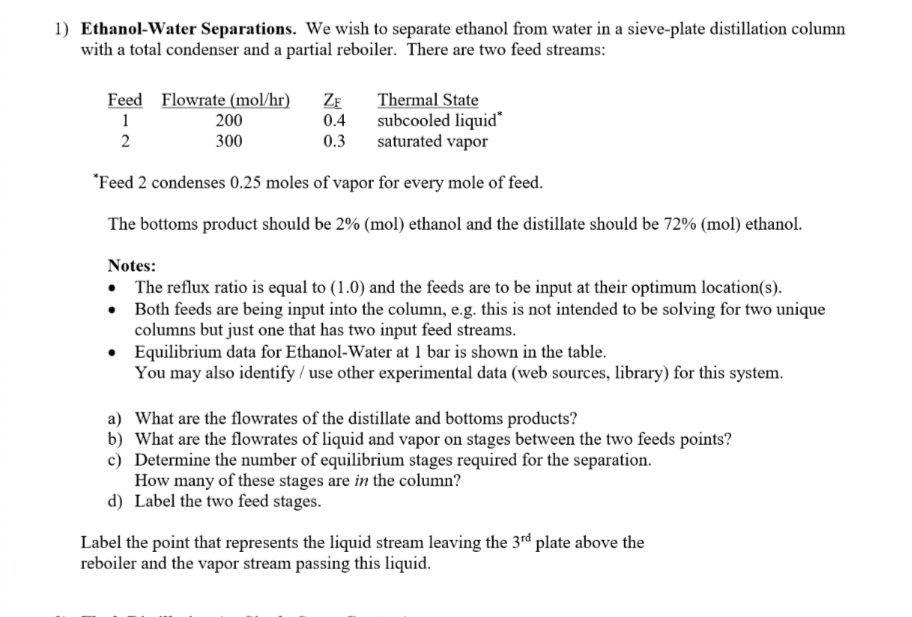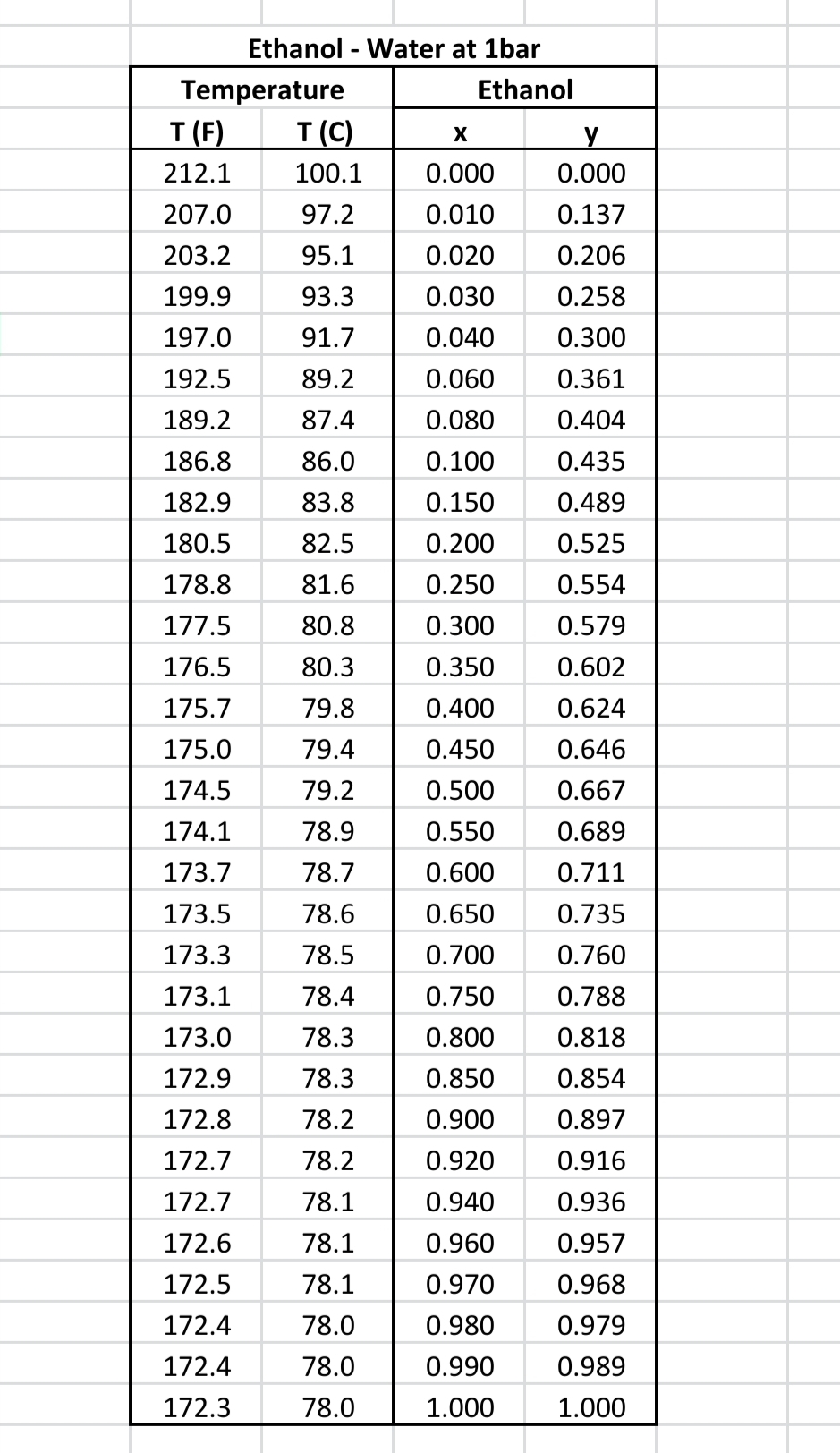Ethanol-Water Separations.
Introduction to Chemical Engineering Thermodynamics
8th Edition
ISBN:9781259696527
Author:J.M. Smith Termodinamica en ingenieria quimica, Hendrick C Van Ness, Michael Abbott, Mark Swihart
Publisher:J.M. Smith Termodinamica en ingenieria quimica, Hendrick C Van Ness, Michael Abbott, Mark Swihart
Chapter1: Introduction
Section: Chapter Questions
Problem 1.1P
Related questions
Question
100%
Solve d) clearly show the Txy graph

Transcribed Image Text:1) Ethanol-Water Separations. We wish to separate ethanol from water in a sieve-plate distillation column
with a total condenser and a partial reboiler. There are two feed streams:
Thermal State
subcooled liquid*
saturated vapor
*Feed 2 condenses 0.25 moles of vapor for every mole of feed.
The bottoms product should be 2% (mol) ethanol and the distillate should be 72% (mol) ethanol.
Feed Flowrate (mol/hr) ZF
1
0.4
2
0.3
200
300
Notes:
• The reflux ratio is equal to (1.0) and the feeds are to be input at their optimum location(s).
•
Both feeds are being input into the column, e.g. this is not intended to be solving for two unique
columns but just one that has two input feed streams.
•
Equilibrium data for Ethanol-Water at 1 bar is shown in the table.
You may also identify /use other experimental data (web sources, library) for this system.
a) What are the flowrates of the distillate and bottoms products?
b)
What are the flowrates of liquid and vapor on stages between the two feeds points?
Determine the number of equilibrium stages required for the separation.
c)
How many of these stages are in the column?
d) Label the two feed stages.
Label the point that represents the liquid stream leaving the 3rd plate above the
reboiler and the vapor stream passing this liquid.

Transcribed Image Text:Ethanol - Water at 1bar
Temperature
T (C)
100.1
97.2
95.1
93.3
91.7
89.2
87.4
86.0
83.8
82.5
81.6
80.8
80.3
79.8
79.4
79.2
78.9
78.7
78.6
78.5
78.4
78.3
78.3
78.2
78.2
78.1
78.1
78.1
78.0
78.0
78.0
T (F)
212.1
207.0
203.2
199.9
197.0
192.5
189.2
186.8
182.9
180.5
178.8
177.5
176.5
175.7
175.0
174.5
174.1
173.7
173.5
173.3
173.1
173.0
172.9
172.8
172.7
172.7
172.6
172.5
172.4
172.4
172.3
Ethanol
X
0.000
0.010
0.020
0.030
0.040
0.060
0.080
0.100
0.150
0.200
0.250
0.300
0.350
0.400
0.450
0.500
0.550
0.600
0.650
0.700
0.750
0.800
0.850
0.900
0.920
0.940
0.960
0.970
0.980
0.990
1.000
y
0.000
0.137
0.206
0.258
0.300
0.361
0.404
0.435
0.489
0.525
0.554
0.579
0.602
0.624
0.646
0.667
0.689
0.711
0.735
0.760
0.788
0.818
0.854
0.897
0.916
0.936
0.957
0.968
0.979
0.989
1.000
Expert Solution
This question has been solved!
Explore an expertly crafted, step-by-step solution for a thorough understanding of key concepts.
This is a popular solution!
Trending now
This is a popular solution!
Step by step
Solved in 5 steps with 5 images

Recommended textbooks for you

Introduction to Chemical Engineering Thermodynami…
Chemical Engineering
ISBN:
9781259696527
Author:
J.M. Smith Termodinamica en ingenieria quimica, Hendrick C Van Ness, Michael Abbott, Mark Swihart
Publisher:
McGraw-Hill Education

Elementary Principles of Chemical Processes, Bind…
Chemical Engineering
ISBN:
9781118431221
Author:
Richard M. Felder, Ronald W. Rousseau, Lisa G. Bullard
Publisher:
WILEY

Elements of Chemical Reaction Engineering (5th Ed…
Chemical Engineering
ISBN:
9780133887518
Author:
H. Scott Fogler
Publisher:
Prentice Hall

Introduction to Chemical Engineering Thermodynami…
Chemical Engineering
ISBN:
9781259696527
Author:
J.M. Smith Termodinamica en ingenieria quimica, Hendrick C Van Ness, Michael Abbott, Mark Swihart
Publisher:
McGraw-Hill Education

Elementary Principles of Chemical Processes, Bind…
Chemical Engineering
ISBN:
9781118431221
Author:
Richard M. Felder, Ronald W. Rousseau, Lisa G. Bullard
Publisher:
WILEY

Elements of Chemical Reaction Engineering (5th Ed…
Chemical Engineering
ISBN:
9780133887518
Author:
H. Scott Fogler
Publisher:
Prentice Hall


Industrial Plastics: Theory and Applications
Chemical Engineering
ISBN:
9781285061238
Author:
Lokensgard, Erik
Publisher:
Delmar Cengage Learning

Unit Operations of Chemical Engineering
Chemical Engineering
ISBN:
9780072848236
Author:
Warren McCabe, Julian C. Smith, Peter Harriott
Publisher:
McGraw-Hill Companies, The